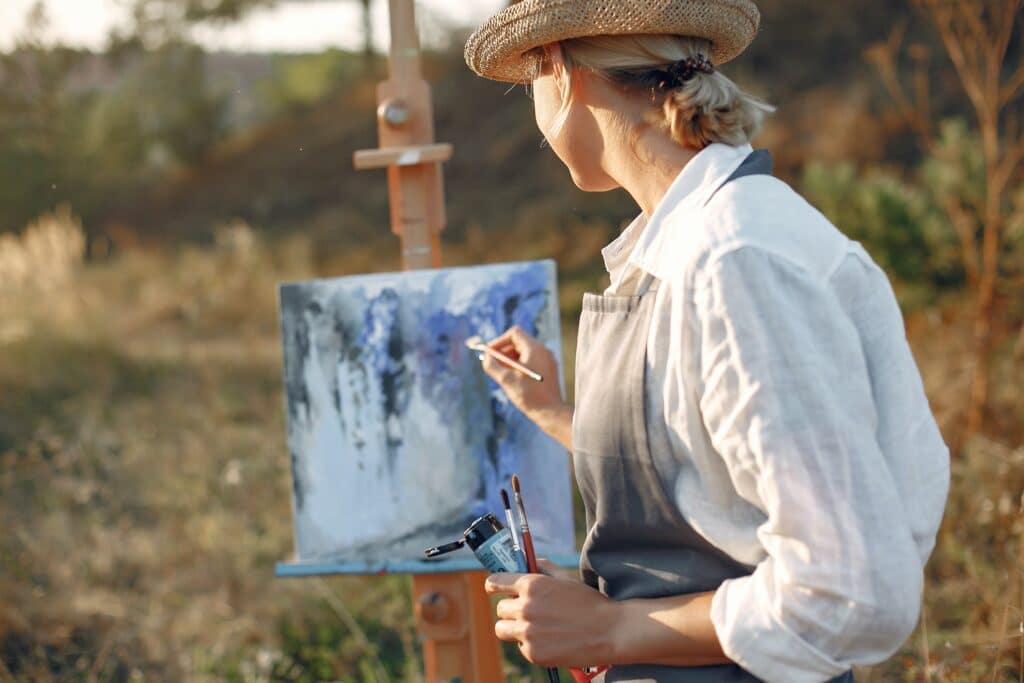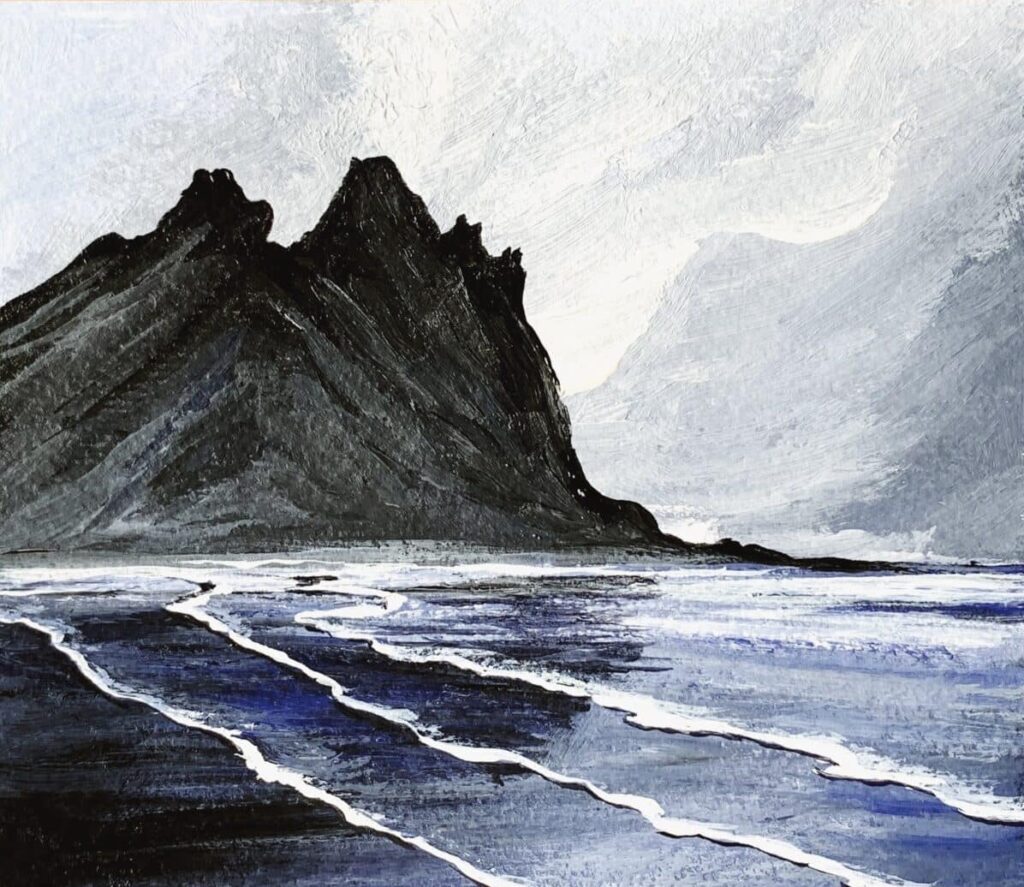Creating compelling and visually captivating landscape paintings requires more than just technical skill. Composition plays a vital role in capturing the essence of the scene, guiding the viewer’s gaze, and conveying the desired mood and atmosphere.
In landscape painting, there are several common composition techniques that artists often utilize to create visually appealing and effective artworks. These compositions have stood the test of time due to their ability to capture the essence of the landscape and engage the viewer.
In this blog post, we will explore 14 composition ideas that can help you enhance your landscape paintings and take them to the next level.
1. Rule of Thirds
The rule of thirds is a foundational composition principle that divides the canvas into a grid of nine equal parts. Placing key elements along these intersecting points or lines creates a visually balanced composition.
The rule of thirds works because it avoids placing the focal point in the center, resulting in a more dynamic and visually engaging composition.
2. 'S' or Compound Curve Composition
The S-shape composition is a powerful technique for creating a sense of movement, flow, and visual interest within a landscape painting.
By incorporating a gentle S-shaped curve or line, artists guide the viewer’s eye through the painting, creating a dynamic and engaging visual journey.
This composition technique works particularly well when elements such as rivers, paths, or winding roads are positioned in a serpentine manner.
Furthermore, the S-shape composition adds depth and perspective to the landscape. As the curve traverses different planes of the composition, it leads the eye from the foreground to the middle ground and background, creating a three-dimensional effect. This depth enhances the realism and spatial perception of the scene, making it more immersive for the viewer.
3. Golden Ratio
The golden ratio is a composition technique based on the mathematical ratio of approximately 1:1.618. Dividing the canvas based on this ratio creates aesthetically pleasing proportions. By aligning important elements along these lines or areas, artists create a sense of harmony and balance.
The golden ratio works because it reflects the natural proportions found in the world, resonating with viewers on a subconscious level.
4. Leading Lines
Leading lines are powerful tools that guide the viewer’s eye through the composition. These lines can be created by elements such as rivers, paths, or fences.
By strategically placing these lines, artists create a visual pathway that draws the viewer deeper into the painting, adding a sense of depth and dimension.
5. 'O' or Circle Composition
The ‘O’ or circle composition is a technique where the main elements of your landscape are arranged in a circular or oval shape.
This composition creates a sense of unity, continuity, and movement within the artwork. It draws the viewer’s eye in a circular motion, allowing for a smooth visual journey through the painting.
Consider incorporating elements such as trees, hills, or bodies of water to form the circular shape and enhance the overall composition.
6. Framing
Framing involves using natural or architectural elements to enclose the composition. It adds depth and context by surrounding the focal point or creating a sense of distance.
By employing overhanging tree branches, arches, or other framing elements, artists focus attention on the subject and provide a sense of visual depth.
7. Steelyard Composition
The steelyard composition is a technique where elements are arranged asymmetrically, creating a sense of balance through visual weight.
This composition involves placing larger or more dominant objects on one side of the painting and balancing them with smaller or less prominent objects on the other side. It creates a dynamic tension and adds visual interest to your landscape painting.
An example could be placing a majestic mountain or a prominent rock formation on one side of the painting, creating a visually dominant element, balancing it out by placing a small cottage or a group of trees on the opposite side, representing a smaller, less imposing element.
8. Diagonal Composition
Diagonal lines can inject energy and dynamism into your landscape paintings. By incorporating diagonal lines in the composition, you create a sense of movement and visual tension.
Diagonal lines can be represented by elements like roads, rivers, or mountains that cut across the canvas diagonally. This composition technique adds a dynamic and engaging quality to your artwork.
Diagonal composition adds visual interest by introducing a sense of tension and leading the viewer’s eye on a dynamic visual journey.
9. Symmetry
Symmetry creates a visually balanced composition by mirroring elements on both sides of the canvas. It evokes a sense of harmony, stability, and order.
Symmetry can be achieved by placing identical or similar elements on each side, resulting in a pleasing and serene composition.
10. Overlapping and Layering
Overlapping and layering involve positioning elements in the foreground, middle ground, and background to create depth and spatial relationships.
This technique mirrors how we perceive the world, with objects in the foreground appearing closer and those in the background receding.
Overlapping and layering bring a sense of realism, immersion, and dimension to the painting.
11. High or Low Horizon
The placement of the horizon line significantly impacts the composition’s overall feel. A high horizon emphasizes the sky, creating a sense of vastness and expansiveness. Conversely, a low horizon focuses on the land or foreground, establishing stability and grounding.
The choice of a high or low horizon depends on the desired mood and emphasis in the painting.
12. Rule of Space
The rule of space involves leaving empty or negative space around the main subject or within the composition. This technique creates a sense of breathing room, allows the subject to stand out, and enhances the overall balance of the artwork.
Negative space can also help convey a feeling of tranquility or emphasize the vastness of the landscape.
13. Emphasis through Contrast
Creating contrast through color, value, texture, or size can emphasize specific elements within the landscape.
By juxtaposing light and dark areas, warm and cool colors, or rough and smooth textures, artists can guide the viewer’s attention to the focal point or important areas of the composition. Contrast adds visual impact and helps tell a compelling visual story.
14. Group Mass Composition
Group mass composition focuses on clustering elements together to create a sense of unity and cohesion.
By grouping similar or related objects, such as trees, rocks, or buildings, you can create a visual impact and reinforce the theme or narrative of your landscape painting.
This composition technique adds depth, texture, and visual interest to your artwork.
Understanding the most common landscape compositions empowers artists to create visually captivating and impactful artworks.
By harnessing these composition techniques, you can enhance the visual impact of your landscape paintings and evoke a sense of wonder and connection with the natural world.
Question for Readers: Which landscape composition technique resonates with you the most, and why? Have you experimented with any of these compositions in your own artwork?
Share your thoughts and experiences in the comments below!





